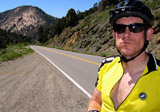Training for Hot Conditions
Legal disclaimer: Since we are not doctors, never follow anything based on health-related topics on this or related sites without first consulting with your doctor or other trusted health professional.
Riding in very hot conditions is not advisable for most cyclists, but is a crucial part of preparing for a race or event that is mercilessly hot. On humidity, I bow out, since I live in California where it’s relatively dry.
I purposefully learned to ride in hot and dry conditions similar to my planned events, often in the 90-100° F range. Training in the heat is both a physiological (sweat, hydration, etc) and psychological challenge, and should not be left for event day.
The Everest Challenge daytime temperatures can hit 95°F with an oven-like effect in some canyons, so one must have some tolerance for such conditions over some hours.
A worst-case scenario was the one year at the Climb to Kaiser. Morning temperatures before sunrise were already close to 90°F, and with some humidity too. By the end of the race, my Polar heart rate monitor was reading 125° F, with a vicious headwind (real air temp was probably 115-118°F, but might have been warmer near the pavement). It was like riding into a huge hair dryer on full. My buddy ended up with hyponatremia.
Training
Only by incorporating training in difficult conditions can one tolerate such extremes. Under such conditions heart rate is what it is— you will slow down involuntarily.
When training, there is no need to beat yourself up or perform hard efforts in the heat. The key is a steady effort that helps you get accustomed to hot conditions, helping your body adapt physiologically, which it does.
Body fat is a huge problem in the heat. Carrying 10 extra pounds of body fat is very, very unpleasant in the heat. Get as lean as you can when your intent is an event which will be hot; a layer of fat is insulating, that’s why seals don’t freeze!
Events
If available in an event, take in cold fluids and douse yourself with water and/or ice packs at a rest stop at every opportunity. Stick an ice pack under your jersey, in your shorts over the quads, or on top of your helmet— it all helps bring down core body temperature.
Another trick (not sure it’s still made) is a CamelBack IceBack, which has no insulation between the bladder and the rider’s back— stuff it full of ice for a mini personal cooling system. I’ve done so in mountain bike races, and it definitely helps, both by cooling the body directly, and by drinking the cold fluid.




